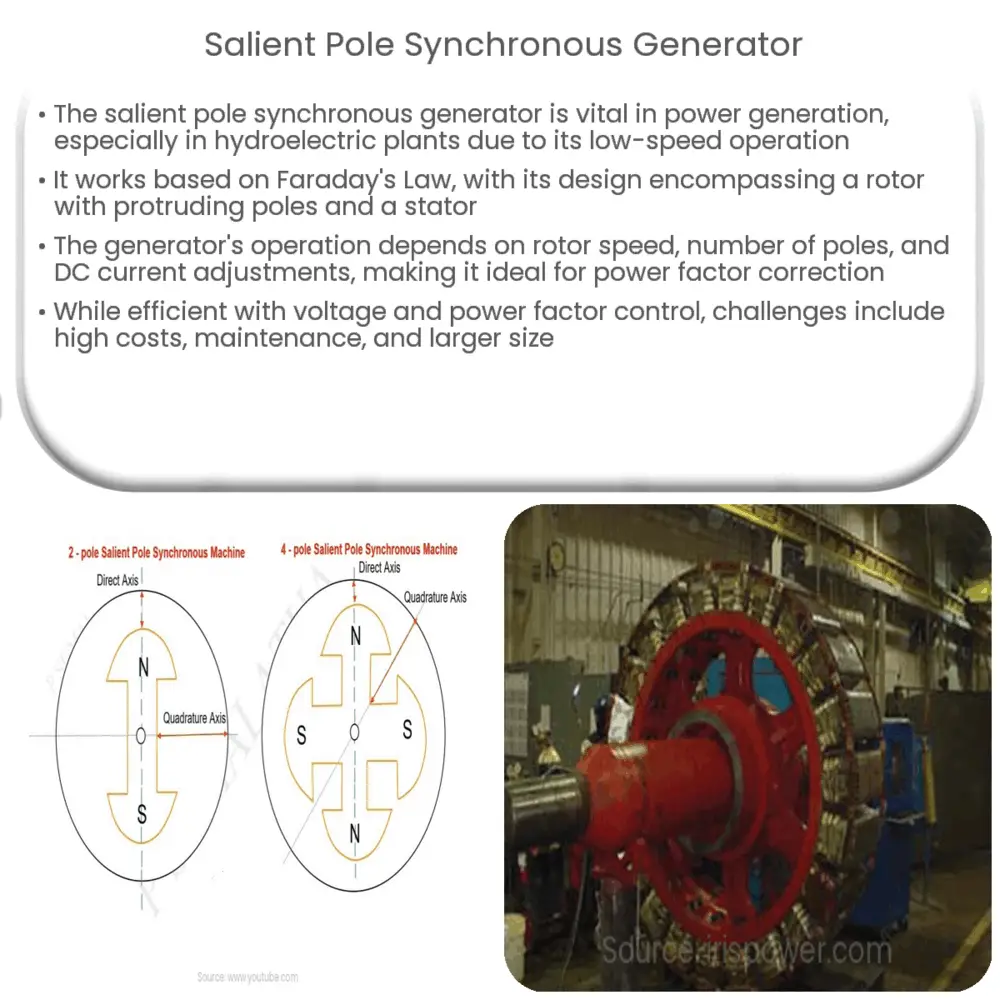Explore the workings, applications, and advantages of salient pole synchronous generators in power generation and industrial use.

Introduction to Salient Pole Synchronous Generator
A salient pole synchronous generator is a type of electrical machine that plays a crucial role in generating electrical power in various industries. It is widely used in hydroelectric power plants due to its capability to operate at low speeds.
Working Principle of Salient Pole Synchronous Generator
The working principle of a salient pole synchronous generator lies in Faraday’s Law of electromagnetic induction. This law states that an electromotive force (EMF) is induced in a coil due to changes in the magnetic field. In a salient pole synchronous generator, the rotor (also known as the field winding) rotates, creating a change in the magnetic field. This, in turn, induces an EMF in the stator (armature winding).
Structure and Design
The design of a salient pole synchronous generator involves two main parts: the rotor and the stator.
- The Rotor: The rotor of a salient pole synchronous generator is characterized by protruding poles. These poles are made up of laminated steel, designed to reduce eddy current losses. The number of poles can vary depending on the application and requirements of the generator.
- The Stator: The stator consists of three-phase windings where the generated EMF is collected. It is designed as a cylindrical shape to uniformly distribute the magnetic flux.
Operational Characteristics
The operational characteristics of a salient pole synchronous generator depend on its design and construction. It operates based on the following principles:
- Frequency: The frequency of the generated voltage is directly proportional to the speed of the rotor and the number of poles.
- Voltage Control: The output voltage can be controlled by adjusting the DC current in the rotor winding.
- Power Factor: Salient pole synchronous generators can operate at any power factor, depending on the load requirement. This makes them suitable for power factor correction in power systems.
In the next section, we will delve deeper into the applications and advantages of salient pole synchronous generators, as well as their challenges and limitations.
Applications of Salient Pole Synchronous Generators
Salient pole synchronous generators find applications in various sectors, including:
- Hydropower Plants: Due to their ability to operate efficiently at low speeds, these generators are widely used in hydroelectric power plants.
- Industrial Plants: They are also used in many industrial plants for power generation, especially in situations where a stable frequency and voltage are required.
- Power Factor Correction: These generators are capable of operating at over, under, and unity power factor, making them suitable for power factor correction in power systems.
Advantages and Challenges
Salient pole synchronous generators come with several advantages:
- Efficiency: These generators have high efficiency and are capable of generating large amounts of power.
- Voltage Control: The output voltage can be controlled, which is beneficial in many applications.
- Power Factor Control: The ability to control the power factor is a significant advantage in power systems.
However, there are also challenges associated with these generators:
- Cost: The construction of salient pole synchronous generators can be complex and costly due to the materials and technology involved.
- Maintenance: The maintenance of these machines can be demanding, especially in the event of wear and tear of the salient poles or rotor windings.
- Size: These generators tend to be larger and heavier than non-salient pole machines, making them less suitable for certain applications.
Conclusion
In conclusion, the salient pole synchronous generator is an essential component in power generation across various sectors. Its ability to efficiently generate electricity, control voltage, and adjust power factor according to demand makes it highly versatile. However, its advantages are balanced with challenges such as high initial costs, maintenance requirements, and size. Nevertheless, the salient pole synchronous generator remains a cornerstone in power generation, contributing significantly to global energy production.

